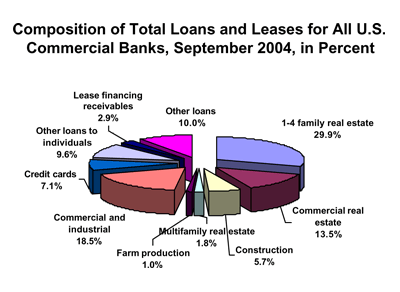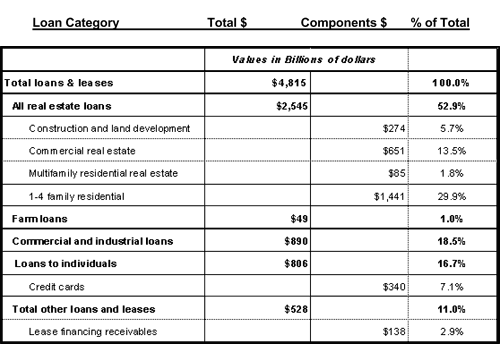Commercial and industrial loans are a major component of the "loans and leases" category of assets that commercial banks report on their balance sheets. Interest and fees that banks earn on loans and leases also are a major source of the revenues they report on their income statements. Besides commercial and industrial loans, or “business loans” as they are often called, other key categories of loans reported by banks and savings institutions include loans secured by real estate, loans to finance agricultural production, and loans to individuals—including credit card loans.
Detailed balance sheet and income statement data are reported quarterly by each depository institution to their respective banking industry regulators—the Federal Deposit Insurance Corporation (FDIC), the Federal Reserve System (FED), the Office of the Comptroller of the Currency (OCC), the Office of Thrift Supervision (OTS), and state financial institution regulators. These data are used by regulators and industry analysts to monitor the performance and condition of banks and the banking industry and by economists to assess the supply of and demand for credit in the economy.
How are “loans and leases” defined?
The Federal Financial Institutions Examination Council (FFIEC) quarterly Reports of Condition and Income (commonly called the “Call Report”) have detailed instructions that describe what types of loans banks are required to report in each loan category. For detailed information on the definitions of any particular asset (including loans and leases), liability (including deposits), income, or expense item, you may review the instructions for these reports via the FFIEC or the FDIC web sites.
Information and instructions for the June 2004 Report of Condition and Income and its various schedules are available at the FDIC web site. For specific information on loans and leases, click on Schedule RC-C: Loans and Leases.
What types of loans and leases do banks make?
Loans and leases represent the largest single asset category on the banking industry balance sheet. On the September 2004 Call Report for All Commercial Banks in the U.S., the industry reported $4.8 trillion in total loans and leases; that figure represented about 58 percent of commercial bank assets. Securities, mainly government bonds and mortgage-backed securities, accounted for another 18 percent of total bank assets.
Of that $4.8 trillion in total loans and leases held by all commercial banks, the single largest loan category, measured as a percentage of total loans, is loans secured by real estate. The next largest category consists of commercial and industrial or “business” loans. Lease financing receivables, one of the smaller loan categories, totaled $138 million, or 2.9 percent of total loans and leases. Chart 1 below indicates the share (as of September 2004) that several different types of loans comprise of total loans and leases outstanding at banks in the nation. For additional detail, Table 1 below indicates the total amount, in billions of dollars, for major loan categories including loans secured by real estate, commercial and industrial loans, loans to consumers, and other loans.
Chart 1

Table 1
Composition of Total Loans and Leases at All Commercial Banks in the Nation as of September 2004 (Billions of Dollars)

Want to know what type of loans your bank makes?
Individual bank Call Report data are available from the FDIC under Call Report and TFR Data. In addition, quarterly aggregate income statement and balance sheet data, including loans and leases, are available by state, as well as for the nation. These aggregate figures are tabulated from individual bank Call Reports; they are available online at the FDIC web site under Statistics on Banking. 1
Endnotes
1. Prior to the spread of interstate banking, aggregate state data included only the assets (and liabilities) of banks headquartered in that state. However, with interstate banking today, aggregate state data may include assets from banks in many states. Thus, the assets of interstate banks headquartered in a state may include assets located in other states where the bank operates (for example, a bank operating in Michigan but headquartered in California typically will report both the Michigan and California assets in California. This tends to overstate bank assets in states where interstate banks are headquartered, and understate them in states where there are few interstate banks.)
References
Assets and Liabilities of Commercial Banks. Board of Governors of the Federal Reserve System. H.8 Release provides weekly and monthly national banking statistics including data by type of loans. http://www.federalreserve.gov/releases/h8/
“How do you define ‘Commercial Loans’ and what is the economic importance of these types of loans?” Federal Reserve Bank of San Francisco, Ask Dr Econ (September 2000). /education/activities/drecon/2000/0009.html
Marquis, Milton H. (2003) “Bank lending to businesses in a jobless recovery.” FRBSF Economic Letter: 2003-21 (July 25, 2003).
Reporting Forms and Instructions. Federal Financial Institutions Examination Council. http://www.ffiec.gov/ffiec_report_forms.htm
Statistics on Banking; Call and TFR Data; Call and Income Report Instructions. Federal Deposit Insurance Corporation. http://www.fdic.gov/